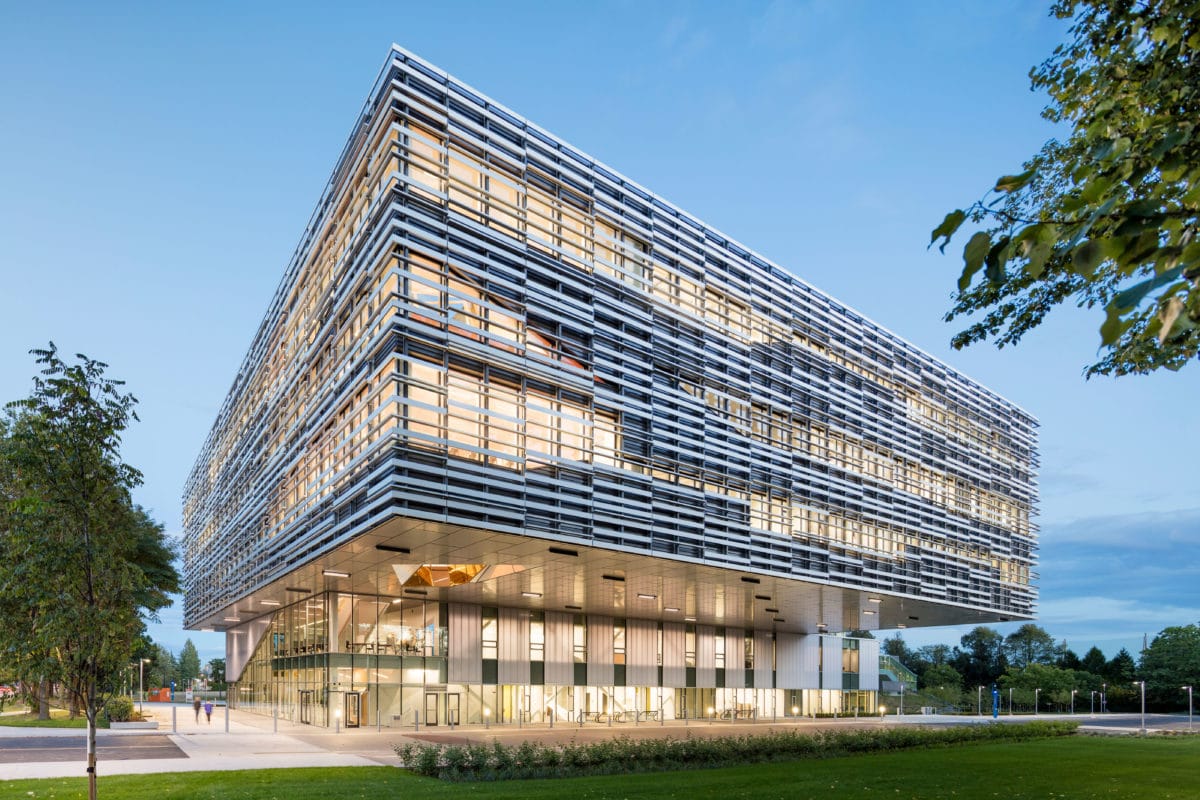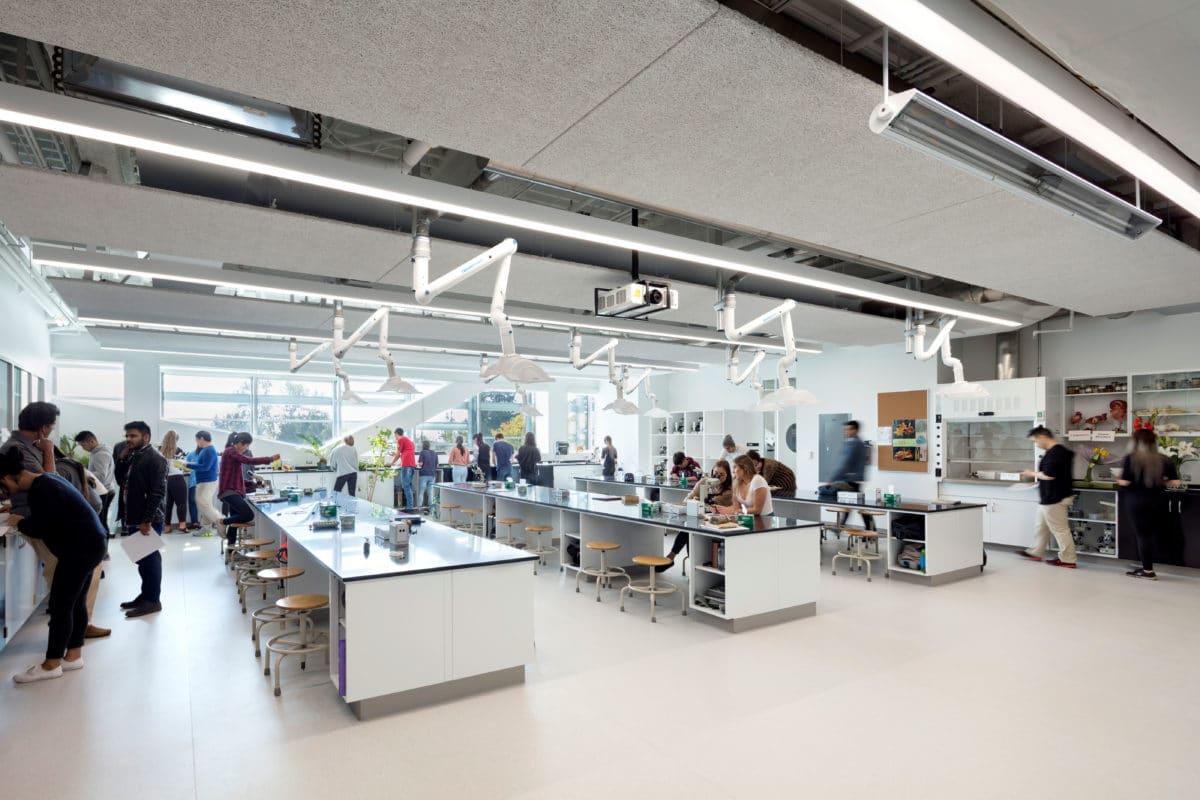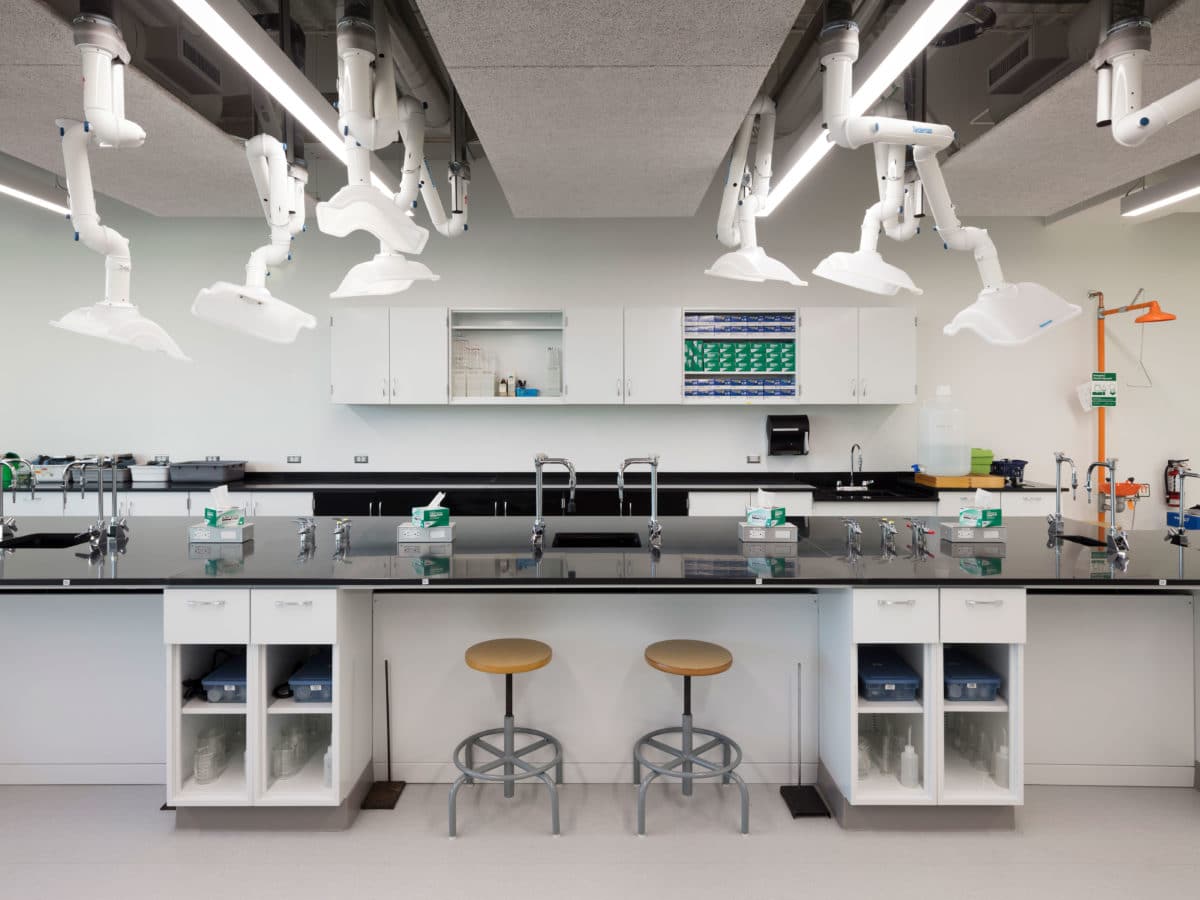
Natural light fills the Langara Science & Technology building, from a massive light well to large windows in classrooms. [Photo by Andrew Latreille]
A bright environment breeds bright students at Vancouver’s new Langara Science & Technology building
It’s only fitting that the building with some of the most inspiring lessons on campus would also be inspiring in appearance. Aesthetically, sustainably, practically—the Langara Science & Technology Building on the campus of Langara College in Vancouver, British Columbia is more than 129,000 square feet of greatness.
“We tried to take advantage of every available space to give back to the students,” says Kori Chan, the principal from Proscenium Architecture + Interiors Inc, who worked alongside principal Stephen Teeple of Teeple Architects on this project.
Chan says his favorite parts of the new Langara building are the student common areas—particularly the Vortex Lounge. “It’s the multi-story space at the northwest corner of the building that contains an oculus in the shape of a crystal,” he says. “The oculus is a spectacular window system designed to draw daylight into the student areas.”

[Photo by Andrew Latreille]
Crystal Clear
Natural light fills the five-story building—home to science, nursing, and computing science labs as well as collaborative study spaces, an instructional greenhouse, and an observation deck. You’ll encounter outdoor views in more than 90% of regularly occupied areas. “Natural light promotes a healthy environment. People feel better when there is natural daylight,” Chan says. “The more natural light we can get to penetrate the building, the less ambient lighting we need to use, thereby reducing energy consumption. The challenge is controlling glare.” The design team used translucent panels on the lower floors and an architectural screen on the top three levels to combat glare while letting in as much natural light as possible.
Then there’s the light well—beautiful and practical. It acts as a return air shaft by taking advantage of how air moves naturally to reduce the need to move it mechanically. And it also allows daylight to shine through the entire building.
On the west side of the building, a 50-foot cantilevered portion dramatically incorporates a skylight window to allow for more natural light.

[Photo by Andrew Latreille]
PROJECT
LOCATION
Vancouver, British Columbia
SIZE
Roughly 130,000 square feet
COMPLETION
August 2016
TEAM
Teeple Architects /
Proscenium Architecture + Interiors
Stephen Teeple, principal, Teeple Architects
Kori Chan, principal, Proscenium
Eric Boelling, associate, Teeple Architects
Tomer Diamante, Teeple Architects
Kathy Chang, intern architect, Proscenium
Ben Plashe, senior technologist
Sustainable at Every Turn
But it’s not all about light in this design. It inspires in other ways, too. Langara is part of the Green Building Audio Tours, a Vancouver project aimed at telling stories about the greenest buildings, in partnership with not-for-profit group Open Green Building Society. As one of the many examples of its commitment to sustainability, Langara goes above and beyond with efficient indoor water use. The project created a model estimate of its indoor water use for plumbing fixtures and found the building could save more than 260 gallons of potable water a year by specifying low flow fixtures with aerators for additional efficiencies. That’s an Olympic swimming pool amount of water each year, or 44% in savings.
Outside, the project includes a large landscaped area that’s protected from future development. The green space serves as an offset for the building in an effort to conserve existing natural areas, provide habitat, and promote biodiversity. And, of course, any fertilizers used there are phosphate-free.
Throughout construction, the project team used low-emitting paints, coatings, adhesives, and sealants in a commitment to air quality. Special attention was paid to flooring emission standards, ensuring the building met the FloorScore IAQ Test Program, which independently certifies that flooring products comply with VOC emissions criteria.
Oh, and when it comes to even getting to the building, you’ll find easy access to public transportation and a cycling route. If you do drive, though, you can recharge your electric vehicle onsite, or park in “preferred parking” if you carpool. Langara encourages minimal vehicle miles and rewards alternative modes of transportation.

[Photo by Andrew Latreille]
Inherent to the Outdoors
The building is designed to fit seamlessly into its environment. While building sites often have asphalt parking areas or dark-colored hardscaped areas, this project doesn’t, Chan says, in an effort to mitigate the heat island effect. Instead, it has what’s called high albedo or low-emissive materials, for lighter, more reflective hardscaping surfaces. The new building is pursuing third party certification via the Canada Green Building Council, aiming for LEED Gold. “This project incorporated a number of efforts to ensure site development impacts were lower than that of a conventional building,” Chan says. From the outside, the building adds just the right amount of texture and pattern without competing with its surroundings.
GREENER & GREATER
The Langara Science & Technology Building also uses
- Bioswales to help with stormwater runoff
- Low emissivity roof
- Sustainable, local building materials
- Energy-efficient building envelope
- Low-flow fume hoods with adjustable sashes
- Daylight harvesting
- Low-impact landscape, with native and drought-tolerant plants and no irrigation, as a way to conserve potable water
- Water-side heat recovery system that targets zero thermal energy waste and preheats domestic hot water
